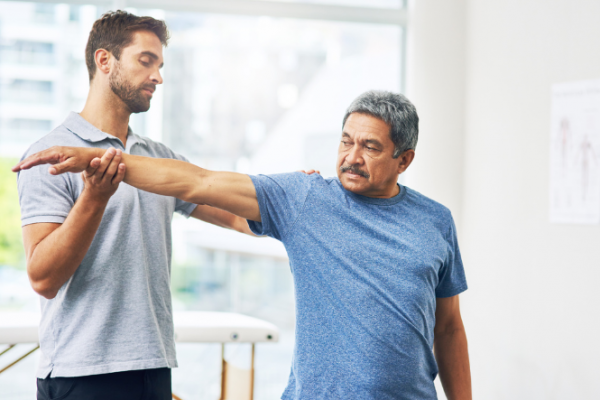Polio and post-polio syndrome
Also called poliomyelitis or PPS
Key points about polio and post-polio syndrome
- Polio (poliomyelitis) is a rare but highly contagious disease caused by a virus.
- Most people who get infected with the polio virus will not have any visible symptoms.
- A smaller number of people can develop very serious symptoms, causing them to become paralysed or even die.
- Post-polio syndrome is a complication of polio where some people develop muscle pain, weakness or paralysis 15-40 years after infection.
- Polio is preventable with vaccination.

Polio is a viral infection that’s easily spread, but is rare due to vaccination. The polio virus invades and kills motor nerves in the spinal cord, nerves that send messages from your brain to your muscles. Damage to these nerves can result in paralysis (being unable to move, and sometimes breathe).
You can catch it if you come into contact with an infected person’s poo, then touch your mouth or your food without washing your hands. Because the virus lives in an infected person's throat and intestines, you can also get it from breathing in droplets if they sneeze or cough. It can contaminate food, milk and water if people don’t wash their hands.
An infected person can spread the virus to other people just before and for up to 2 weeks after symptoms appear. Even if you have no symptoms, you can still pass the virus on to others and make them sick.
Polio usually affects tamariki under 5 years of age. Fortunately the polio vaccine has wiped out polio in many countries, including Aotearoa New Zealand. However, there is still a risk of catching it when travelling overseas and of polio entering New Zealand when travellers return.
This page from the Center for Disease Control has a map showing where polio is in the world(external link).
This page from the Immunisation Advisory Centre has a video about polio(external link).
Most people infected with polio virus have no symptoms. But, while infected, they can still shed the virus and spread the disease.
About 4 to 8 in 100 cases might have flu-like symptoms such as:
- sore throat
- fever
- tiredness
- nausea or vomiting
- headache
- sore stomach or stomach pain
- neck stiffness.
These symptoms usually last 2 to 5 days then go away on their own.
A smaller proportion of people with poliovirus infection will develop other more serious symptoms that affect their brain and spinal cord:
- Paraesthesia (feeling of pins and needles in the legs).
- Meningitis (infection of the covering of the spinal cord and/or brain) occurs in about 1 out of 25 people with poliovirus infection. Read more about meningitis.
- Paralysis (can’t move parts of the body) or weakness in the arms, legs, or both, occurs in about 1 out of 200 people with poliovirus infection. Paralysis is the most severe symptom associated with polio because it can lead to permanent disability and death. Between 2 and 10 out of 100 people who have paralysis from poliovirus infection die because the virus affects the muscles that help them breathe.
If you have been travelling and think you may have polio, make an appointment to see your doctor immediately and tell them why, so they can see you safely.
There's no treatment to reverse the paralysis. This is why immunisation with the polio vaccine is so important.
The polio vaccine protects children by triggering their immune system to develop antibodies to fight the polio virus.
Almost all children who get all the recommended doses of vaccine will be protected from polio.
There are 2 types of vaccine that can prevent polio:
- The inactivated poliovirus vaccine (IPV) has been used in Aotearoa New Zealand since 2002 and is the preferred form.
- The oral poliovirus vaccine (OPV) is given as drops in the mouth. It’s still used in some countries.
Travellers are advised to be up-to-date with polio vaccinations before heading overseas or visiting countries where polio is common or where an outbreak has occurred. Read more about polio vaccination.
We don’t know why, but some people who’ve had polio, develop symptoms (eg, muscle pain, weakness, or paralysis) years or decades later as a result of the disease. This is referred to as the late effects of polio (LEoP) or post-polio syndrome. Having had a severe polio infection seems to be factor in developing post-polio syndrome.
Symptoms of post-polio syndrome might include:
- feeling tired
- muscle weakness and pain that gets worse over time
- sleep problems
- breathing or swallowing problems
- losing muscle tissue.
There’s no cure for PPS but it usually progresses slowly in most people. Living with the late effects of polio can be challenging and it requires a lot of medical help.
Treatments can help you manage your symptoms. These include:
Physical activity
New muscle weakness can appear in the muscles affected by the original polio as well as in muscles that weren’t affected. Therefore, strengthening, stretching and aerobic exercises are recommended. However, exercise should be carefully monitored by a health professional so you don’t overdo it.

Image credit: Canva
Work-life balance
Fatigue or tiredness is a common problem following polio. Keeping active and having physiotherapy can help as well as maintaining a balanced lifestyle (not overdoing things). A healthy diet helps increase energy levels and assists with weight management.
Pain management
Post-polio muscle and joint pain, overuse pain and positional pain is common. Improving posture and supporting weakened muscles with things like braces, mobility aids, special seats and/or tailored physiotherapy can help with pain. Your healthcare provider can often help organise these things for you or whānau.
Sleep and breathing assessment
Polio can cause sleep problems years later due to things like muscle pain and breathing problems because of weakened chest and tummy muscles. A consultation with a sleep and respiratory specialist is recommended to help identify the cause of any sleep or breathing problems. Your healthcare provider can organise a consultation with the right specialist.
Urologist consultation
Bladder malfunction (which can cause peeing problems) is common in people who’ve had polio due to weakened muscles and poor mobility. A consultation with a urologist is recommended to understand the underlying cause and possible treatment options. Your healthcare provider can organise a consultation with the right specialist.
Keep warm
People who have had polio often feel the cold more. So wearing lots of layers, having a warm environment and using things like heat pads can help.
Swallowing and speech difficulties
Damage to the nerves and muscles involved in swallowing and talking can be a result of polio. Therefore, an evaluation by a specialist is recommended. Your healthcare provider can help organise this.
Mental and emotional wellbeing
Managing your mental and emotional wellbeing can also help with managing physical symptoms. The onset of symptoms later in life can also trigger memories of the original illness, which can be distressing. Talking to whānau, friends or a trained counsellor can help.
Your healthcare team
Due to the complexity and variety of symptoms, a large team of specialist healthcare professionals is often required to manage the late effects of polio. This could include a:
- podiatrist for your feet
- speech pathologist
- neurologist for pain
- rehabilitation specialist
- GP or nurse practitioner
- physiotherapist
- occupational therapist
- orthotist for prosthetics
- respiratory specialist for breathing
- sleep specialist
- urologist
- psychologist
- dietitian
- massage therapist
- osteopath for musculoskeletal pain.
Polio(external link) Immunisation Advisory Centre NZ
Immunisation handbook (poliomyelitis - page 444)(external link) Health New Zealand | Te Whatu Ora, 2024
Polio(external link) Centers for Disease Control
Polio and post-polio syndrome(external link) Medline Plus
Brochures
Polio vaccine – what you need to know(external link) Centers for Disease Control and Prevention (CDC), US English(external link), Chinese – Simplified(external link), Chinese – Traditional(external link), Dari(external link), Farsi(external link), French(external link), German(external link), Hindi(external link), Italian(external link), Khmer (Cambodian(external link)), Thai(external link), Turkish(external link), Urdu(external link), Vietnamese(external link)
References
- Polio(external link) Immunisation Advisory Centre, NZ, 2022
- Polio (Poliomyelitis)(external link) CDC, Centers for Disease Control and Prevention, US, 2024
- Poliomyelitis update for clinicians(external link) Health New Zealand | Te Whatu Ora, 2022
- Post-polio syndrome(external link) Mayo Clinic, US, 2022
- Polio and the late effects of polio(external link) Better Health, Australia, 2021
Poliomyelitis(external link) Health New Zealand | Te Whatu Ora, 2023
The late effects of polio introduction to clinical practice(external link) Polio NZ
National polio outbreak preparedness and response framework for Aotearoa New Zealand(external link) Ministry of Health, NZ, 2023
Credits: Healthify editorial team. Healthify is brought to you by Health Navigator Charitable Trust.
Reviewed by: Dr Art Nahill, Consultant General Physician and Clinical Educator
Last reviewed:





